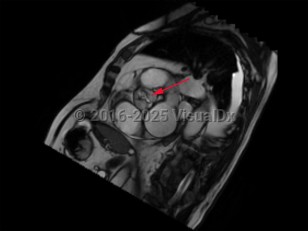Aortic stenosis
Synopsis

Contributing etiologies include calcification of the aortic valve cusps (most common in the elderly population), congenital abnormalities (ie, bicuspid aortic valve), rheumatic fever, chest radiotherapy, endocarditis, and alkaptonuria. Potential complications include heart failure, cardiac arrhythmias, infectious endocarditis, pulmonary hypertension, excessive bleeding, stroke, and other embolic events.
There is no known medical therapy available to delay progression of AS. Patients should be monitored carefully with serial clinical evaluations and echocardiography in order to determine if and when aortic valve replacement is needed, which may be performed by surgical aortic valve replacement or transcatheter aortic valve replacement (TAVR), also known as transcatheter aortic valve implantation (TAVI). Prolonged or intense physical activity and competitive sports should be avoided in patients with severe AS.
Codes
I06.0 – Rheumatic aortic stenosis
I35.0 – Nonrheumatic aortic (valve) stenosis
SNOMEDCT:
60573004 – Aortic valve stenosis
Look For
Subscription Required
Diagnostic Pearls
Subscription Required
Differential Diagnosis & Pitfalls

Subscription Required
Best Tests
Subscription Required
Management Pearls
Subscription Required
Therapy
Subscription Required
References
Subscription Required
Last Updated:05/15/2024

